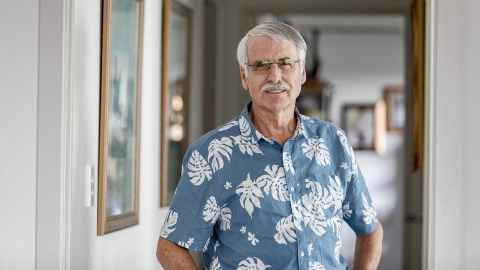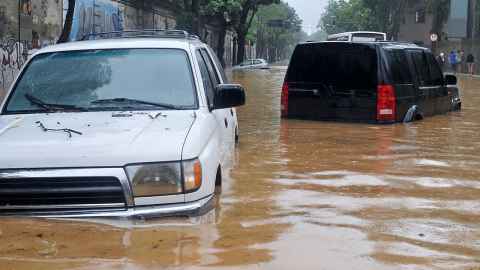Kevin Trenberth: communicating climate science with urgency
1 August 2023
Dr Kevin Trenberth didn’t let injuries from an incident involving his Shih Tzu and a pit bull stop him from picking up the phone to talk about climate change.

Climate scientist Dr Kevin Trenberth explains climate change to journalists from The Washington Post to 95bFM, rarely refusing a request.
“When I started off there were science reporters on the smaller newspapers in the US – then they gradually started disappearing,” the 78-year-old says from Rothesay Bay, where he lives with wife Gail. “Now, only really major news media like The New York Times and The Washington Post have them.”
If anyone’s qualified to talk about the climate, it’s Kevin.
Hanging on a wall, a certificate from the Intergovernmental Panel on Climate Change (IPCC) recognises his contribution to the IPCC winning a Nobel Peace Prize in 2007, shared with former US Vice President Al Gore, for informing the world on climate change.
From 1996 to 2017, Kevin had the highest tally of highly cited papers for an environmental scientist, according to a study published in journal PLoS. In Held v Montana, the landmark climate-change case seeking to hold the state accountable for pro-fossil fuel policies, he was an expert witness for the young plaintiffs.
Retirement in the US drew Kevin and Gail back to New Zealand to be closer to a daughter and her family, the Trenberths slipping in just before Covid-19 restrictions blocked borders in 2020.
Now an honorary academic with the Department of Physics at the University of Auckland, he’s contributing to scientific papers, delivering talks, and explaining El Niño and La Niña to anyone who asks. His book The Changing Flow of Energy Through the Climate System with a foreword by Al Gore, was published by Cambridge University Press in 2022.
Targets set by the Paris Agreement in 2016 are to restrict the average increase in the world’s global surface temperature to 1.5 degrees Celsius above the pre-industrial level (probably impossible) or 2 degrees (unlikely).
Earth’s overall energy imbalance is Kevin’s focus. Because of an ever-thickening blanket of greenhouse gases, incoming energy from the sun isn’t matched by energy heading back out to space. The imbalance doesn’t seem much: about one part in 250 of the energy flowing through our climate system, he says.
However, for the ocean, which absorbs most of the extra energy, he says that’s the equivalent of about seven Hiroshima atomic bombs detonating each second, 24 hours a day, 365 days a year. Warming was evident in the top 500m of the global ocean by about 1980. Twenty-five years later in 2005, waters as deep as 2km were warming, a remarkable feat for an immense body of water.
Born in Christchurch, Kevin loved mathematics and playing rugby, graduating from the University of Canterbury with a Bachelor of Science with first-class honours in 1966 after studying applied mathematics including relativity and quantum mechanics, dynamics and mechanics, and fluid dynamics.
“Then I had to find a job – the closest I could find was in atmospheric science, meteorology,” he says.
Employed by the New Zealand Meteorological Service in Wellington, he experienced first-hand the violent storm of 10 April 1968 when the inter-island ferry Wahine disaster killed more than 50 people.
As Kevin drove along a coastal road, awash from raging seas, winds lifted the front wheels of his tiny Austin A35 car and sandblasted paint off the vehicle.

“Getting to the Met Office in Kelburn, right at the peak of the storm with 200 km per hour gusts, I rounded a corner of the building to make for the entrance but was knocked back four times.”
Across the city, roofs and debris were flying through the air.
Visiting the US courtesy of a New Zealand research fellowship for doctoral studies from 1968-71, Kevin met his wife-to-be, bought a Mustang, and completed a thesis on sudden warming in the stratosphere, at the Massachusetts Institute of Technology. Unaffordable New Zealand house prices – what’s changed? – and low pay encouraged a semi-permanent move to the US in 1977.
Thrillers lining a bookshelf are a clue to Kevin and Gail’s eventual destination. Author Stephen White sets his crimes in Boulder, Colorado, Kevin’s home for most of his career, working at the National Centre of Atmospheric Research (NCAR).
El Niño (a periodic increase in sea surface temperatures in the eastern Pacific Ocean), climate variability, rain and the water cycle, and the energy cycle were key interests. Kevin used observational data extensively to understand what happened in the real world and how well computer models replicated those climate observations.
“All models are wrong, some are useful,” is an assessment he quotes approvingly.
Robotic deep-diving floats checking conditions in the oceans and advances in the capabilities of super-computers have aided climate modelling, he says, but shortfalls remain.
“El Niño is not simulated adequately,” Kevin says. “Precipitation is a big shortfall in every model that I’ve looked at – the amounts are generally about right but it’s the frequency and intensity, which are most affected by climate change, that remain a challenge.”
Sophisticated global climate models with detailed simulations of clouds can involve a quintillion (a billion billion) calculations per second and suck up the energy output of a small nuclear reactor, illustrating why the power consumption of supercomputers “is a real issue”, Kevin says.
The Trenberths’ Shih Tzu poodle cross Ethan trots into Kevin’s home office. The dog featured in a traumatic and life-changing event late last year. Struggling with a pit bull attacking Ethan, Kevin was thrown over a bank, smashing his pelvis and badly damaging a leg and foot, injuries still limiting his mobility, interfering with his fitness regime, and keeping his golf game on hold.
Stuck in hospital, where he caught Covid-19, Kevin demurred from television interviews but pressed on with others, such as discussing climate change reparations with 95bFM.
As a self-professed introvert, Kevin is an unlikely climate communicator. First talking to journalists as a junior weather forecaster in Wellington, his clear explanations of science would later lead to thousands of interviews, from CNN to podcasts to Playboy. He answers questions from students who email him. In 2013, the American Geophysical Union awarded him their Climate Communication Prize.
A knack of being in the wrong city at the wrong time has seen Kevin experience more than his fair share of climate disasters: the Wahine storm; Lower Hutt flooding in 1976; Superstorm Sandy in New York in 2012; record flooding in Boulder in 2013; and Cyclone Gabrielle in New Zealand this year. (He was also in Christchurch for the earthquake of February 2011.)
“Raindrops keep falling on my head,” is the title of his chapter in the just-published book Adventures in Climate Science, an anthology of personal essays by climate scientists.
In a memoir, yet to be published, he describes his extensive involvement in the World Climate Research Programme, and authoring IPCC scientific assessments. He witnessed oil producers such as Saudi Arabia fighting to water down IPCC assessments, and was one of the victims in “Climategate,” where hacked emails from climate scientists were distorted by climate-change deniers to sow confusion.
We have to live with some warming and the best we can hope for is to slow the process down and build resilience to the new extremes.
Over decades, some of his key messages are unchanged.
It’s real, the problem is cumulative, and we’re causing it. Today’s blanket of greenhouse gases would disperse only over centuries. Cutting emissions is the most important of all possible responses.
Interviewed on the US national public broadcaster’s PBS Newshour in December 1997, as negotiators met in Kyoto, Japan, to set targets for limiting emissions, he talked of more intense rain, worse droughts, and the difficulty of adapting to faster rates of change in the climate than had ever occurred in nature.
“We have to live with some warming,” he says now. “And the best we can hope for is to slow the process down and build resilience to the new extremes.”
By Paul Panckhurst
This story first appeared in the August 2023 edition of UniNews.